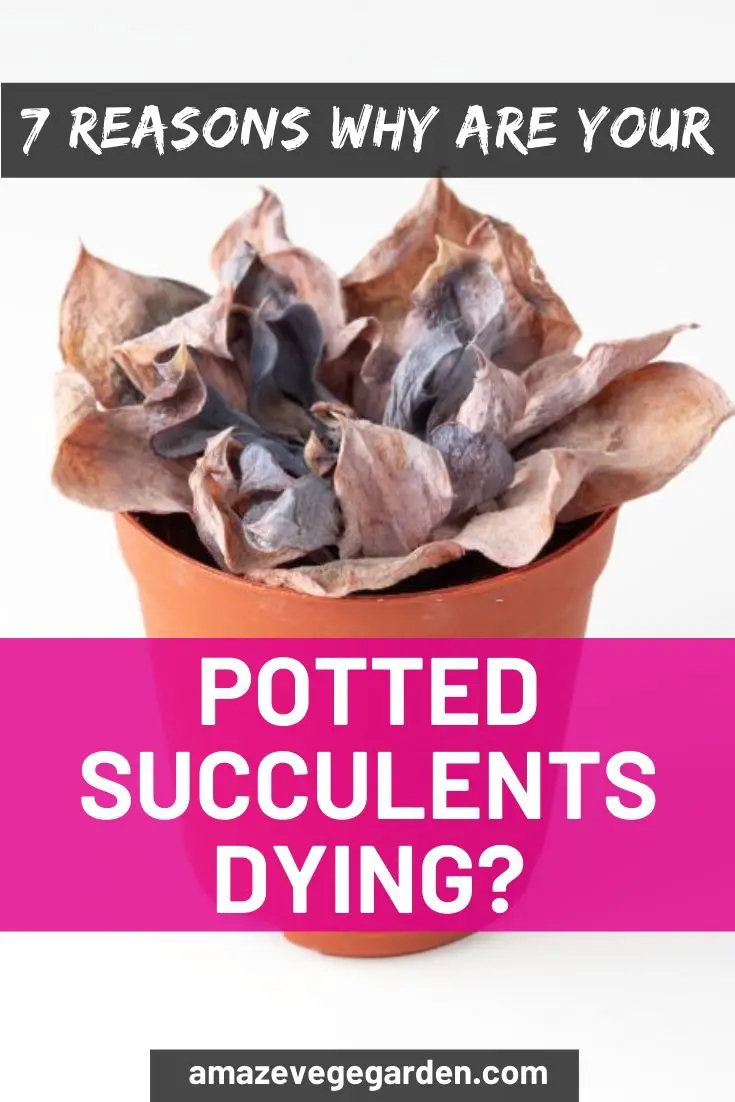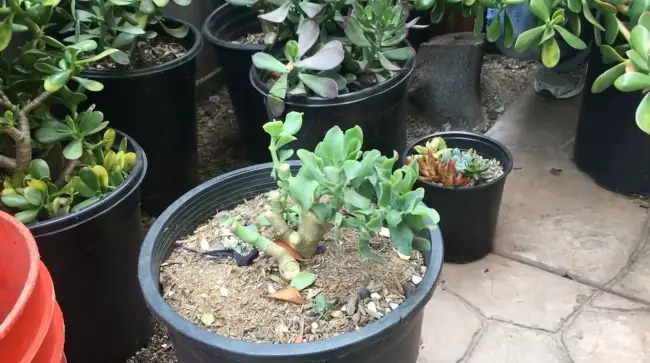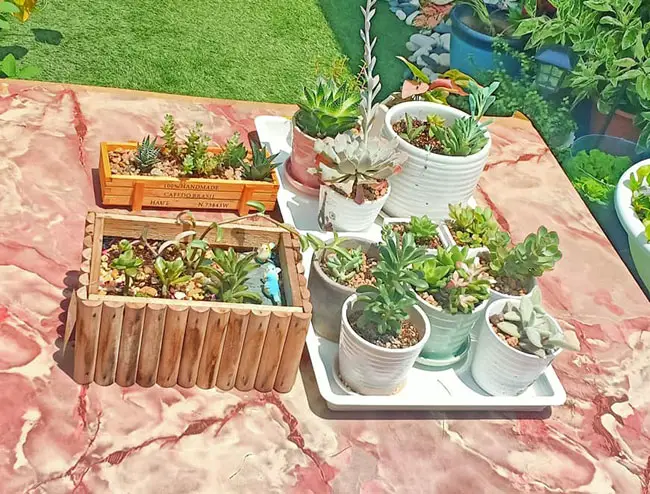Have you ever gone to the store and bought a beautiful, vibrant potted succulent only to have it die within weeks or even days? It’s no fun. You feel like you wasted your money, but don’t worry; there’s hope yet.
You may think that keeping a potting plant alive is simple enough, but when it comes down to it – there are many factors that could contribute to its demise without us being aware of them. Sometimes when you look at your dying succulent, you can’t find any obvious sign of infestation. Also, you will find that the appearance of the plant is looking quite healthy. So what actually happens to the succulent?
Let’s see what the reasons that can cause your succulent to die are.
Over Watering
This is the major issue for most people who are having the succulents dying problem. This is something that all of us have done at some point. So why does watering kill a plant? Well, a few things begin to happen when you overwater your succulents.
They become very susceptible to diseases that can kill them. You actually drown your succulents as they need some air and oxygen around the root area. So if the roots are sitting in water, then the plant begins to drown literally.
It tends to happen during winter when your succulents got over-watered because they’re growing much slower in the winter, and they don’t use as much water as they did in other seasons.
If you notice your succulents begin to turn brown or yellowish, you should stop watering them and letting them dry out. Once it is dry out, it may begin to get some nice new growth, and the plant will continue to thrive.
Succulents don’t like soaking wet. That was the problem if your succulents are sitting in water for several weeks, and one of the repercussions of that is that the leaves will begin to fall off.
They can fall off quite quickly, so you need to stop watering them when you see some new leaves start to come out.
Frequently Moving
Have you ever been so excited about a potted succulent that you just had to bring it home with you? It’s only natural, of course. After all, these fascinating plants can be an attractive addition to any space. But what many don’t realize is that frequently moving them can actually lead to death in the long run.
One of the most important things when caring for potted succulents is keeping their environment consistent. If they are constantly being moved around and disrupted, it can cause major stress on the plant and its root system. This kind of disruption affects how much water and nutrients it will absorb from its soil, leading to dehydration or even too much moisture depending on the conditions. Furthermore, this constant upheaval prevents the roots from establishing themselves in one place which leads to stunted growth and eventual death if left unchecked.
So before taking your new purchase out into the world with you, consider leaving it at home where it won’t have to endure such frequent changes in its environment. Sometimes they can lose their leaves if you move the plant out of its normal position. This could cause it to abort the flower. So when it’s coming into flower, do not move your cactus or succulents.
Keep It Too Dry
Another common problem when it comes to potted succulents is keeping them too dry. When the soil in a pot doesn’t get enough moisture, the plant’s leaves will start to wrinkle and become brittle. This can happen even if you water your plants regularly, as either not enough water is being absorbed by the soil or the air around the pot is too dry.
To prevent this from happening, make sure that the soil has plenty of moisture and that there isn’t any standing water in the pot. Additionally, if you live in an area with extremely dry air, consider using a humidifier near your plants to keep their environment moist.
Although watering your succulent correctly helps reduce stress on its leaves, it still takes up energy for it to absorb the water and use it for growth. Too much frequent watering may cause some foliage to wilt and die off – so save energy for other leaves by only giving your succulent just what it needs! Furthermore, be careful about how often you move your potted succulents; even slight changes in temperature or light levels can disrupt their delicate balance and put unnecessary strain on their system
Save Energy for Other Leaves
The main reason why some succulents drop their leaves or flowers is for the reason of saving energy. They can look like dying even if you have kept them well-watered. This is because the plant is not having enough energy to raise all the leaves. For it to continue to survive, it will start to drop some leaves so you can distribute the energy to others.
It’s a sad statistic, but many potted succulents die within the first six months of being cared for. That can be especially disappointing if you’ve had your eye on that special species or have been nurturing it since its arrival at your doorstep. But there are some key steps to take in order to ensure your little friend lives a long and healthy life!
The best way to save energy for other leaves is by focusing on providing adequate sunlight and water for your plant. Succulents need about four hours of direct sun each day, with more during the summertime when temperatures tend to rise. When watering, always check the soil before adding any liquid; if it feels damp, then skip this step! Additionally, avoid using too much fertilizer as it can lead to over-fertilization which can stunt growth and cause leaves to turn yellow or brown.
Remember those succulents prefer their roots to stay somewhat dry – so be sure not to overwater them or keep them in standing water for extended periods of time. Taking these precautions will help extend your plant’s lifespan and provide an opportunity for you to enjoy its beauty longer.
Aging
Different succulents have different life spans. Some may die after a few years, and some can live up to 100 years. For example, Hens and Chicks have a lifespan of 3 years on the lower end. While for the Jade Plant is a lifetime plant where it can live for many years, like 70 to 100 years.
Aging is a natural process that can be accelerated when the succulent isn’t cared for properly. A potted succulent may age more quickly if it’s not getting enough sunlight, or if it’s not receiving adequate hydration. Too much water can cause root rot and other issues, which will eventually lead to the plant dying prematurely. On the other hand, too little water causes dehydration, causing leaves and stems to wither away.
It’s important to maintain a balance of light exposure and hydration for your succulents in order to ensure they have a long life span. If you notice any signs of aging such as yellowing or wilting leaves, then it’s time to adjust the watering schedule or move your plants around so they get different amounts of sun throughout the day.
The best way to prolong the life of a potted succulent is to give it plenty of attention and affection—just like you would with any living thing! By providing just enough sunshine and hydration while also giving them love and care, you’ll be sure to keep them healthy until their natural lifespan has reached its end.
Read also: How To Save A Dying Jade Plant
Pest Invasion
It’s very devastating to a gardener because they can lose most of their succulents to pests. The blossoming of insect populations is because they are following our habits. Many people are turning to succulents as a kind of architectural piece in the landscape, and they are very low maintenance.
Once they’re established, they’re great plants to have. But pest is just terrible when you found them in your yard.
To combat pest infestations, you’ll need to take action as soon as possible. Start by gently removing affected leaves with tweezers or rubbing alcohol-soaked cotton swabs; this will help reduce the population size of the pests and prevent further spread.
You may want to introduce beneficial insects such as ladybugs into your environment which will naturally prey on the smaller insects that feed on your plants. Finally, consider spraying neem oil onto the soil surface around your potted succulents – this natural pesticide has been known to have success against certain types of pests without harming other life forms.
Diseases
Some succulents are dying because of diseases. Some common diseases can infect the life of succulents.
Viral Disease
The viral disease is one kind of disease that succulents can infect. Most of the time, succulents are getting viruses through insects when the insects are feeding on the succulent sap. To prevent viral disease, you need to take good care of your succulents by ensuring no insects come close to them.
Fungal Disease
Fungi tend to be caused by cold weather like wintertime or rainy season. When your succulents get wet and cold for a certain period of time, the fungal will start to be found on the plant. If you didn’t treat them, your succulents might end up dying.
Edema
This disease is caused by excess fluid retention. What happens is when they are deprived of moisture for a long time, and they get too much moisture, the cell inside of their leaves gets ruptured. This can also cause little lesions on the outside of the plant and turn the leaves into a cork-like texture. This disease is prevalent in Jade.
It’s important to pay attention to the signs that your succulent may be suffering from a disease. Symptoms include wilting leaves, discolored foliage or stems, stunted growth, and strange spots on the plant. If you spot any of these symptoms it is important to act fast and treat the problem immediately with appropriate treatment.
Luckily there are many treatments available for diseases that affect potted succulents. Homemade remedies like baking soda solution or neem oil spray have been proven effective against fungal infections while other commercially available products can help control bacterial infections. Whatever method you choose make sure to follow instructions carefully so as not to harm your precious plants!
Why Are The Bottom Leaves Of Your Succulents Dying?
When the lower leaves on your succulents start to die or look bad, it can put you into a panic and cause you to find all kinds of remedies to try to save your succulents.
But there might not actually be any cause for alarm. I will discuss what the lower leaves of your succulents are telling you and whether or not you actually have a problem.
First, let’s talk about dried-up leaves on the bottom of your succulents. This is actually really normal for succulents, and all of the leaves at some point are going to die just like any other plant.
The lower leaves will eventually die off and make room for new growth. Sometimes this happens in a month, and sometimes it happens, maybe over the course of a year. This can vary depending on the type of succulent you have.
However, if you notice that an unusually high number of leaves are shriveling up and dying, there’s likely something wrong going on. If the leaves are dry, it’s most likely that your succulent isn’t getting enough water. In this case, you’ll want to increase your watering frequency gradually.
Making sure that you’re using the soak and dry method to ensure your succulents are getting a good deep watering and then have that period of time to dry out to enable really healthy root growth. Don’t make any drastic changes to your watering frequency over the next few weeks, and your succulents will begin to look better. The new growth will perk up, be healthy, and be firm.
You’ll notice that the lower leaves on the succulents that are already dried up won’t recover or come back alive. But you may notice new growth on this stem where those leaves used to be. If you find that instead of drying up, the lower leaves on your succulents are turning yellow or translucent, this is a sign that they’re getting too much water. Your first inclination may be that you’re watering it too frequently.
Using dense soil or soil that doesn’t drain can actually be just as problematic. You’ll first want to make sure that your succulent is in well-draining soil. If it is, then start to reduce your watering frequency gradually. It’s probably a good idea also to leave your succulent for about a week without water. Making sure that the soil is completely dry from top to bottom after letting the soil dry out completely.
You’ll want to make sure you are watering less frequently. You may not want to make drastic changes again because that can be problematic. But you will want to make sure you’re allowing a few more days between each watering.
Final Thought
It can be heartbreaking to watch your beloved potted succulents slowly whither away. Knowing why these plants are dying is an important step in preventing future losses and keeping them happy and healthy. As we have seen, frequent moving, inadequate watering, energy conservation for other leaves, aging, pest invasions, and diseases can all contribute to the demise of a once-thriving plant.
But don’t despair! With proper planning and care you should have no problem growing healthy succulents that will bring beauty and life into your home or garden. A few simple steps such as providing appropriate amounts of sunlight, water, soil amendments, and regular check-ins with your local nursery can go a long way toward ensuring success. I hope this article has given you some insight into how to prevent your precious potted succulent from fading away too soon.
Ultimately it’s up to us as caregivers to provide our plants with what they need in order to thrive – love, attention, and natural elements like light and water.
Did you find this post useful? Would you like to get back to it later? Save THIS PIN below to your succulents board on Pinterest! 🙂




Hello! I have a beautiful Jade plant that my mom got me for my 20th birthday back in October. I love plants, I have so many!!! This one is especially special to me. Recently (about a month ago) a small bump to the plant and 5 leaves would fall. I ignored it the first couple of times and put the leaves ontop of the soil so they could callus over so I could replant. Well. I should have been more proactive about this. After about a week of me noticing this, I started investigating. The plant was so healthy and plump, I wasn’t able to see the soil because it was so full. When I went to go take a look at it, there was a layer of mold on the soil!!! The leaves rotted and the trunks were surrounded. I know right aways it was overwatered and it was not getting enough oxygen to the soil. I unpotted it, took all the soil off and took out the rotted rotted and trunks. There were probably 5-7 trunks, and I removed 3. I then added largeish rocks to the bottom of the pot and some plastic mesh for draining. I repotted and the same has continued to happen. It have been slowing down now. It’s been about a month now, I still haven’t watered it. It’s looking bare and really sad.
Is there still hope for this guy? Or do I just disassemble and propagate what’s left? Any pointers would be much appreciated!!
It sounds like your Jade plant may be suffering from root rot, which is a common problem with overwatered plants. Removing the rotted roots and trunks was a good first step, but it’s possible that the plant is still struggling to recover. Here are some tips for helping your Jade plant recover and thrive:
Make sure your soil is well-draining: Jade plants don’t like to sit in wet soil, so it’s important to use a soil mix that drains well. You can also add perlite or sand to your soil mix to improve drainage.
Water sparingly: After repotting, you should avoid watering your Jade plant for at least a few weeks to give it time to recover. When you do water, make sure the soil is completely dry before watering again. In general, it’s better to underwater than overwater your Jade plant.
Provide plenty of light: Jade plants like bright, indirect light. Make sure your plant is getting enough light to promote healthy growth.
Consider fertilizing: Once your plant has had a chance to recover, you can consider fertilizing it with a balanced, all-purpose fertilizer. Follow the instructions on the package for best results.
Be patient: It may take some time for your Jade plant to recover fully. Be patient and give it time to adjust to its new conditions.
If your plant continues to struggle, it may be best to propagate what’s left and start over with a new plant. Good luck, and I hope your Jade plant recovers soon!